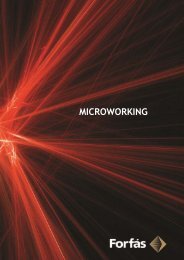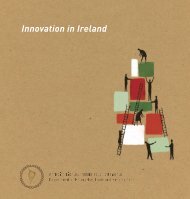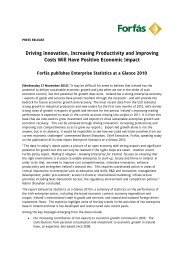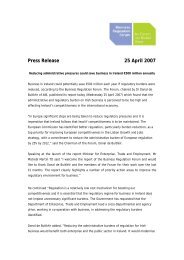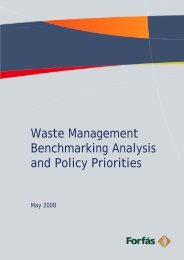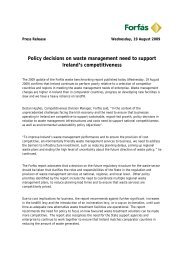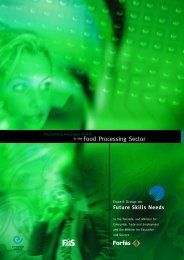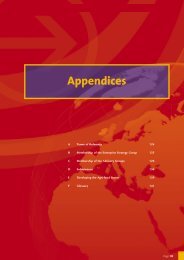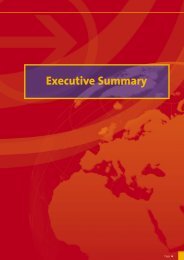Sustainability of Research Centres - Advisory Science Council
Sustainability of Research Centres - Advisory Science Council
Sustainability of Research Centres - Advisory Science Council
Create successful ePaper yourself
Turn your PDF publications into a flip-book with our unique Google optimized e-Paper software.
It is assumed that for most <strong>of</strong> the centres currently in Groups 1, 2 and 3 that the majority <strong>of</strong> the<br />
overhead contribution paid by funders is allocated to the host institution and that the host institution<br />
may, at their discretion, allocate it back to the centres. For Group 4 it is assumed that they retain all<br />
overhead contributions (for standalone centres).<br />
The distribution <strong>of</strong> funding between the HEI (block grant etc.) and competitive funding would change<br />
if the overall balance <strong>of</strong> funding between the two were to change at national level e.g. if full<br />
economic costs (FEC) were agreed by funding agencies.<br />
The models recognise the relatively low capacity for industry funding <strong>of</strong> RDI in Ireland but,<br />
nevertheless, assume that at least some <strong>of</strong> the industry contributions are cash rather than in-kind for<br />
Group 2 (<strong>of</strong> the order <strong>of</strong> 10-20% <strong>of</strong> the industry contributions in cash) and a greater proportion <strong>of</strong> cash<br />
for Groups 3 (at least 50% <strong>of</strong> the industry contributions in cash in the earlier phase <strong>of</strong> operation, and<br />
targeting 80% in the longer term).<br />
Figure 6 illustrates the minimum expectation <strong>of</strong> funding levels in each group. The expected minimum<br />
proportions <strong>of</strong> funding from each source are based on the size <strong>of</strong> the annual base-centre-fund. For<br />
example based on the archetypal diversification model for Group 2, if €X is provided as a base-centre-<br />
fund to a centre, and the private sector income is expected to be 20% <strong>of</strong> the funding, then at a<br />
minimum € (X/40)*20 should be leveraged through private income. This does not prohibit centres from<br />
leveraging greater amounts <strong>of</strong> funding from the various sources <strong>of</strong> income (which will ultimately<br />
change the proportions <strong>of</strong> funding from each source reported). However, these levels should be<br />
monitored closely by funders; for centres to deliver on their expected outputs in a sustainable manner<br />
requires that an appropriate level <strong>of</strong> strategic planning, management and activity is in place that is in<br />
proportion with the level and type <strong>of</strong> the ongoing research activity. If centres actively have<br />
opportunity to increase their sources <strong>of</strong> non-base-centre-funds significantly above the targets set out,<br />
then funders should give due consideration to an increase <strong>of</strong> the base-centre-funds as deemed<br />
appropriate to ensure the strategic intent <strong>of</strong> the centre stays intact.<br />
For any group, new centres would require higher proportions <strong>of</strong> public funding to support them for<br />
several years while they become established (this does not mean necessarily greater amounts <strong>of</strong> public<br />
funding, but that the income from other sources may be small at first). This is particularly relevant to<br />
Group 3 if a limited number <strong>of</strong> new RTO centres are to be created to fill the identified gap in the<br />
research centre landscape.<br />
Furthermore, while the models have a focus on the public:private funding ratios, it is recognised also that<br />
public competitive funding can be further categorised into exchequer and non-exchequer funding.<br />
The EU Framework 7 Programme (FP7) currently has a growing annual budget and is a source <strong>of</strong> non-<br />
exchequer funding 86 . Engagement in this programme <strong>of</strong>fers multiple benefits for researchers and research<br />
centres, apart from the funding associated with a particular project. Whilst a number <strong>of</strong> Irish research<br />
centres have been very successful in winning funds from this source, there is significant growth potential<br />
for Irish centres in terms <strong>of</strong> winning European funds. <strong>Centres</strong> should be encouraged to engage at a<br />
86 The total budget for FP7 was €50 billion from 2007-2013. The budget for the follow on programme European Programme Horizon 2020-The<br />
programme for <strong>Research</strong> and Innovation 2014-2020, is anticipated to be €80 billion.<br />
<strong>Sustainability</strong> <strong>of</strong> <strong>Research</strong> <strong>Centres</strong> 37 June 2012



